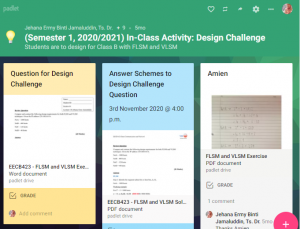 Course overview
Course overview
The course introduces students to fundamental concepts and principles of data communications and networks. It highlights the importance of network design in a networked world. Topics covered include basic data communication, the Open System Interconnect (OSI) and TCP/IP Protocol Suite reference models, Internet Protocol (IP) and addressing schemes, physical addressing, and popular applications such as web browsing and e-mailing. Upon completion of the course students are able to apply fundamental concepts associated with network planning, deploy appropriate techniques in troubleshooting network configurations, and solve issues related to real-life network scenarios.
Participants in piloting
This is a core, compulsory course for students enrolled in the Bachelor in Electrical and Electronics Engineering (Hons.) and Bachelor in Computer and Communication Engineering (Hons.) Programs at Universiti Tenaga Nasional. The course is part of the 3rd year curriculum. On average, a total of 30 – 70 students attend this course every semester. It bears 3 credit points that correspond to a 3 hour lecture each week.
Use of ALIEN services and tools
This included some challenging topics that are best covered through active learning methods. One such topic was network planning for IPv4. For this activity, students were asked to design a network based on specific criteria and requirements. The problem was shared the Moodle® and Padlet® learning management systems. It was also uploaded onto the ALIEN problem-based learning platform allowing easy access.
 The learning objective of the activity was to develop subnetting skills among students, allowing them to design a network based on specific requirements. Students were worked in groups of 4 – 5 individuals using the In-Class Teams approach. At the beginning of the session, each group was asked to analyze requirements before designing a network. This activity allowed students to develop a list of design criteria. It further challenged them consider aspects related to subnet tabulating. Next, team members assumed the roles of moderator, author, reviewer, scriber, reviewer, and author.
The learning objective of the activity was to develop subnetting skills among students, allowing them to design a network based on specific requirements. Students were worked in groups of 4 – 5 individuals using the In-Class Teams approach. At the beginning of the session, each group was asked to analyze requirements before designing a network. This activity allowed students to develop a list of design criteria. It further challenged them consider aspects related to subnet tabulating. Next, team members assumed the roles of moderator, author, reviewer, scriber, reviewer, and author.
Subsequently, each group was given a sample subnet table and was asked to fill it with different criteria on the desirable number of subnets and hosts. Each group member ensured that the team’s network design met the assigned criteria. Group members completed the subnet table with the required information, which included subnet number, host number, and subnet mask. At the end of the activity, teams uploaded their network design containing the subnet details to the Padlet® platform, including the full description of the network design. Each group presented their network design and supporting details and was later interviewed by the instructors to assess students’ comprehension. The instructors then collected important network design criteria and discussed the outcome of the activity in the class at the end of the session.
Due to COVID-19 restrictions, the activity took place virtually using the MSTeams® platform. The instructor had the opportunity to “visit” each group, observe discussions, and offer help when needed. The MSTeams® platform further allowed the recording of presentations for evaluation purposes.


